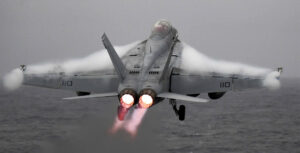Every now and then you have to pull out an old message and give it a new status. This is also the case here.
The F/A-18E Super Hornet fighter aircraft that was swept off the flight deck of the USS Harry S. Truman in the Mediterranean on 8 July due to sudden adverse weather conditions was located at a depth of 2,895 metres less than 24 hours after the incident, but was only recorded as "recovered" after 27 days. Nevertheless, a remarkable achievement!
Well-established team
Once again, the usual suspects that the US Navy calls in to help in such cases were deployed: the remote-controlled underwater robot CURV-21, SUPSALV (Supervisor of Salvage and Diving) and Phoenix International with its multi-purpose Construction Vessel (MPV) Everest. The team's most notable achievement was the recovery of an MH-60S Seahawk helicopter from a depth of 19,075 feet, which the US Navy had lost off the coast of Japan in January 2020. However, this was the third time this team had to be deployed within a year! However, this also shows the US Navy's ability to quickly pursue successful solutions even in seemingly very difficult situations.
Returns to USA
The remains of the aircraft were handed over to the US Navy in Sicily in makeshift packaging (even the blue rubbish bags are bigger for the Americans!). In mid-August, it was transferred to the roll-on/roll-off ship USNS Mendonca (T-AKR 303, Bob Hope class, Military Sealift Command) for onward transport to America for detailed examination. And what will be the outcome? To ensure that something like this never happens again, an additional box will probably be added to the notoriously long checklist before a catapult launch on board an aircraft carrier: In strong winds - deploy double chains!
Original contribution
Climate change hits aircraft carrier: USS Harry S. Truman loses a Super Hornet in the Mediterranean

On Friday, 8 July 2022, a strong gust of wind is said to have blown a Boeing F/A-18E Super Hornet (single seat) off the flight deck of the aircraft carrier USS Harry S. Truman in the Mediterranean. The aircraft was unoccupied, and apart from one person, no one else was injured. Geophysicists believe that a so-called "microburst" was partly responsible for the incident due to the weather conditions in the area. That sounds spectacular - and must be taken with a grain of salt!
"Picked and muscled!"
As the carrier's jets, which weigh a good 16 tonnes, are always moored to the upper deck with chains, even a 150 km/h gust of wind can generate considerable lifting forces on the wings, but cannot simply push the aircraft over the coaming! Unless you were manoeuvring the jet on the deck, i.e. setting it up and getting it ready for use, pulling/pushing it to a parking position with engine power, or it was simply swept away from the lift unsecured. In any case, it must have been phenomenal carelessness, a previously unexplained accident or an unusual meteorological event that caught the "Truman" by surprise - or a combination of all of the above. Perhaps it was just an incomplete assessment of the weather situation that led to the loss of the 67-million-dollar attack fighter.

Microburst
Microbursts are downward air currents of very limited extent that can hit the ground with hurricane force in thunderstorms and are then deflected radially outwards. Similar to tornadoes - only in reverse. A good 35 years ago, they were still responsible for various aircraft accidents, but today's established forecasts and warnings have drastically reduced these. Nevertheless, the weather situation in the Aegean was unusual: a strong low-pressure core with a centre over northern Italy and strong cold air currents at high altitude - all of this passing over Mediterranean water that had already heated up to 4° above the already high normal value. This is a highly unstable weather situation.
Salvage
Now the U.S. Navy will probably think about salvaging it again, because you don't want to leave a piece like this lying around unattended on the seabed. Too many other nations are looking for something like this for their technical collections. The U.S. Navy's partners who specialise in this type of work are well-rehearsed due to various aircraft losses in recent months - and in the Mediterranean, you don't have to dive quite as deep as was necessary during the last salvage operations in the South China Sea (3,780 metres).











One Response
Summary: nothing is known for sure.
Suggestion: please give the article another "new status" when the position of Pluto to Saturn including Ascendant and the birth hour of the captain are correlated with the event.